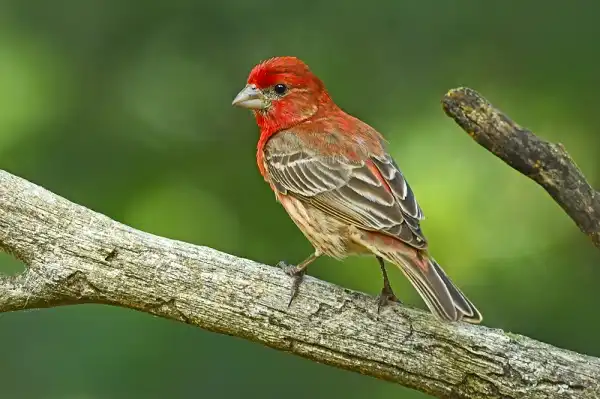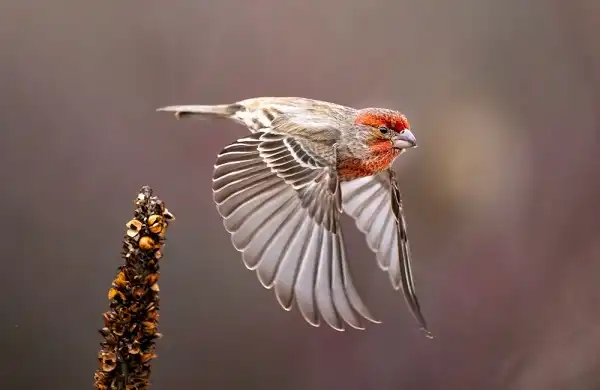Are you a fan of perky songbirds with charming personalities? If so, the House Finch should be right up your alley! These little birds have been gracing American backyards for many decades and are some of our most abundant and beloved feathered friends. With their delightful chirps, vibrant reddish-orange coloring, and willingness to swoop in close to admirers, it’s no wonder why they’re such sought-after avian companions. In this blog post, we’ll take an in-depth look into all things House Finch – from their natural history to how you can attract them to your backyard. So without further delay, let’s explore the wonders of these cheerful little finches!

House Finch Description
The House Finch is a small perching songbird with a vibrant reddish-orange head and chest. The back, wings, and tail are usually plain brown in color, but can sometimes feature flecks of red or yellow. Males tend to be brighter in color than females and also have a bright red streak on their brows. House Finches have large curved bills perfect for cracking open seeds, as this is their primary food source. They also love to snack on berries and suet, making them popular visitors at backyard bird feeders. During the breeding season, they may use parts of cactus plants to construct their nests.
House Finch Habitat
House Finches are quite adaptable and can be found living in many different habitats throughout North America. They typically prefer open woodlands, grasslands, farmlands, gardens, and suburban areas. In the wild, these birds may build their nests using parts of cactus plants or other vegetation close to the ground. As they are opportunistic feeders, House Finches will take advantage of whatever food sources are available near their nesting sites. This includes seeds from grasses as well as fruits and insects. These songbirds also thrive in urban settings where there is an abundance of bird feeders and bird baths for them to use. They have become so accustomed to humans that they often seek out backyards with birdhouses and feeders in order to make a home. House Finches are typically found in small flocks or alone during non-breeding periods. During the breeding season, pairs will form tight bonds and defend their territory aggressively against other birds. These hardy little birds do not migrate long distances but instead, move around in search of ideal feeding grounds or more temperate climates during winter months. They may even travel hundreds of miles away from their original nesting site if necessary!
House Finch Diet
The House Finch is an opportunistic feeder that will consume a wide variety of food sources. Their primary diet consists of seeds from grasses, fruits, and insects. For their daily protein needs, they also love to snack on suet and other high-fat foods. House Finches are usually found around bird feeders filled with black oil sunflower seeds, millet, safflower seed, and other types of wild bird seed blends. They can also be attracted to feeders containing cracked corn, mealworms, berries, and suet. In the wild, these birds may also take advantage of natural food sources such as nectar from flowers or insects caught during flight. During breeding season they may even eat baby birds or mice in order to keep their nests well stocked! These songbirds have specialized bills designed for cracking open small seeds and nuts. They have brush-like tongues that help them slurp up nectar from flowers and other sources as well. Additionally, their feet are specially adapted for clinging onto tree branches while they sing or forage for food.

House Finch Size
The House Finch is a small songbird with a length of 5-6 inches and a weight of 15-25 grams. Males tend to be more brightly colored than females, with bright red streaks around their brows and vibrant reddish-orange heads and chests. Their back, wings, and tail are generally brown in color, but may also feature flecks of red or yellow. The House Finch’s bill is long and curved – perfect for cracking open seeds and other sources of nutrition. These birds are also highly adaptable to their environment; they can thrive in wild woodlands as well as urban cities. This makes them one of the most widely distributed species across North America from Canada to Mexico. They have even been observed living in Hawaii!
House Finch Lifespan
The House Finch is known to have a fairly long lifespan, with individuals living from 5 to 15 years in the wild. While they may live longer in captivity, such as in aviaries or zoos, this is not necessarily reflective of their average lifespan in the wild. House Finches are hardy birds that can survive in a variety of climates and habitats and often require little human intervention to thrive. This is likely due to their ability to find food sources such as seeds, fruits, insects, and suet year-round. They also have an impressive level of agility that allows them to move quickly and deftly amongst trees and other vegetation while foraging. The age at which House Finches reach maturity will vary depending on conditions but generally takes place around 1 year of age. Once mature, these birds may reproduce multiple times throughout the year and are capable of raising up to three broods per breeding season. Aside from reproduction, House Finches also play an important role in keeping insect populations down by consuming larvae and other pests on plants. They help maintain balance within ecosystems by providing food for larger animals while simultaneously controlling the spread of disease among human populations.
House Finch Behavior
House Finches are primarily diurnal birds, meaning they are active during the day and sleep during the night. They are also highly social creatures that can be seen in small flocks or pairs depending on the season. During the breeding season, these pairs will form tight bonds and defend their territory against other birds. In addition to being opportunistic feeders, House Finches demonstrate a variety of vocalizations including chirps, trills, whistles, and warbles which they use to communicate with one another in both territorial defense and courtship rituals. They may even sing as an expression of joy or just for fun! In fact, they often seek out backyards with birdhouses and feeders in order to make a home for themselves! Because of this adaptability, these songbirds have become one of America’s most beloved backyard companions – providing hours of entertainment each day with their cheerful chirping songs.

House Finch Speed
House Finches are known for their impressive agility and maneuverability when in flight. They have long, pointed wings and short tails that help them move quickly and efficiently between trees and other vegetation. In general, they fly at speeds of up to 25 miles per hour but can reach up to 35 miles per hour while chasing after insects or avoiding predators. House Finches are also adept at hovering in one spot, allowing them to take advantage of food sources such as nectar from flowers without having to constantly flap their wings. In addition to their impressive speed, House Finches are also skilled acrobats! These little birds can perform loops, turns, dives, and other complex maneuvers on a dime – making them expert navigators of weather and terrain alike. They often use this skill to outmaneuver any potential predators that may be lurking about. The House Finch’s remarkable flying capabilities make it an integral part of many ecosystems by controlling insect populations while providing vital nutrient sources for larger animals such as hawks who may prey upon these songbirds during migration season.
House Finch Diseases and Health Concerns
The House Finch is generally a hardy species and can tolerate many different climates and habitats, but it is still susceptible to some diseases and health issues. Mites, ticks, and other parasites can cause skin irritation or anemia in these birds, while bacterial infections such as salmonellosis or avian pox can be deadly if left untreated. Viral infections like avian flu can also be dangerous for House Finches, especially since they are often seen in flocks and may easily spread the virus amongst one another. Signs of infection include lethargy, difficulty breathing, loss of appetite, lack of coordination, and sudden death. House Finches should be monitored closely for any signs of disease or distress so that any potential issues can be addressed right away. Regular checkups by a qualified avian veterinarian are a great way to ensure that these beloved songbirds stay healthy for years to come!
House Finch Hunting
House Finches are highly skilled hunters, relying on their agility and speed to capture their prey. They will actively hunt for insects such as beetles, caterpillars, grasshoppers, and ants, as well as larger animals like mice and small birds. These birds also take advantage of other food sources such as seeds, fruits, suet, and nectar. House Finches have also been known to show great resourcefulness when it comes to hunting; they may use tools such as twigs or rocks to break into harder-to-reach areas or dig up grubs from the ground. Additionally, these birds may even store seeds or cached food for future consumption – a behavior that has been documented in some members of the finch family but is rare amongst songbirds. Overall, House Finches are remarkable hunters that demonstrate impressive skills in order to provide sustenance for themselves throughout the year. Their agility and resourcefulness make them important members of many ecosystems by helping maintain balance within their environment while providing us with hours of entertainment each day!

Conclusion
The House Finch is a delightful and hardy species that has become an integral part of many backyard environments across the United States. These songbirds demonstrate remarkable agility in flight, using their impressive speed and maneuverability to access food sources with ease. Additionally, they are not afraid of humans and may even seek out backyards with birdhouses or feeders in order to make a home for themselves. House Finches are also susceptible to diseases and health issues, so it’s important to monitor them closely for any signs of distress. Regular checkups by a qualified avian veterinarian can help ensure that these beloved birds remain healthy for years to come!
Frequently Asked Question


